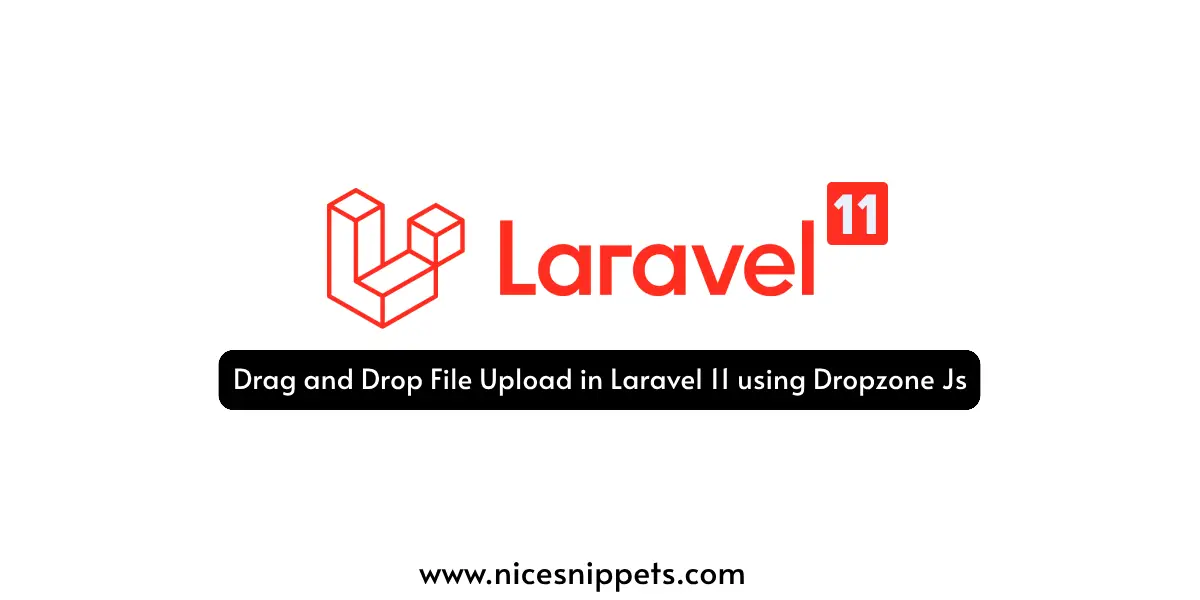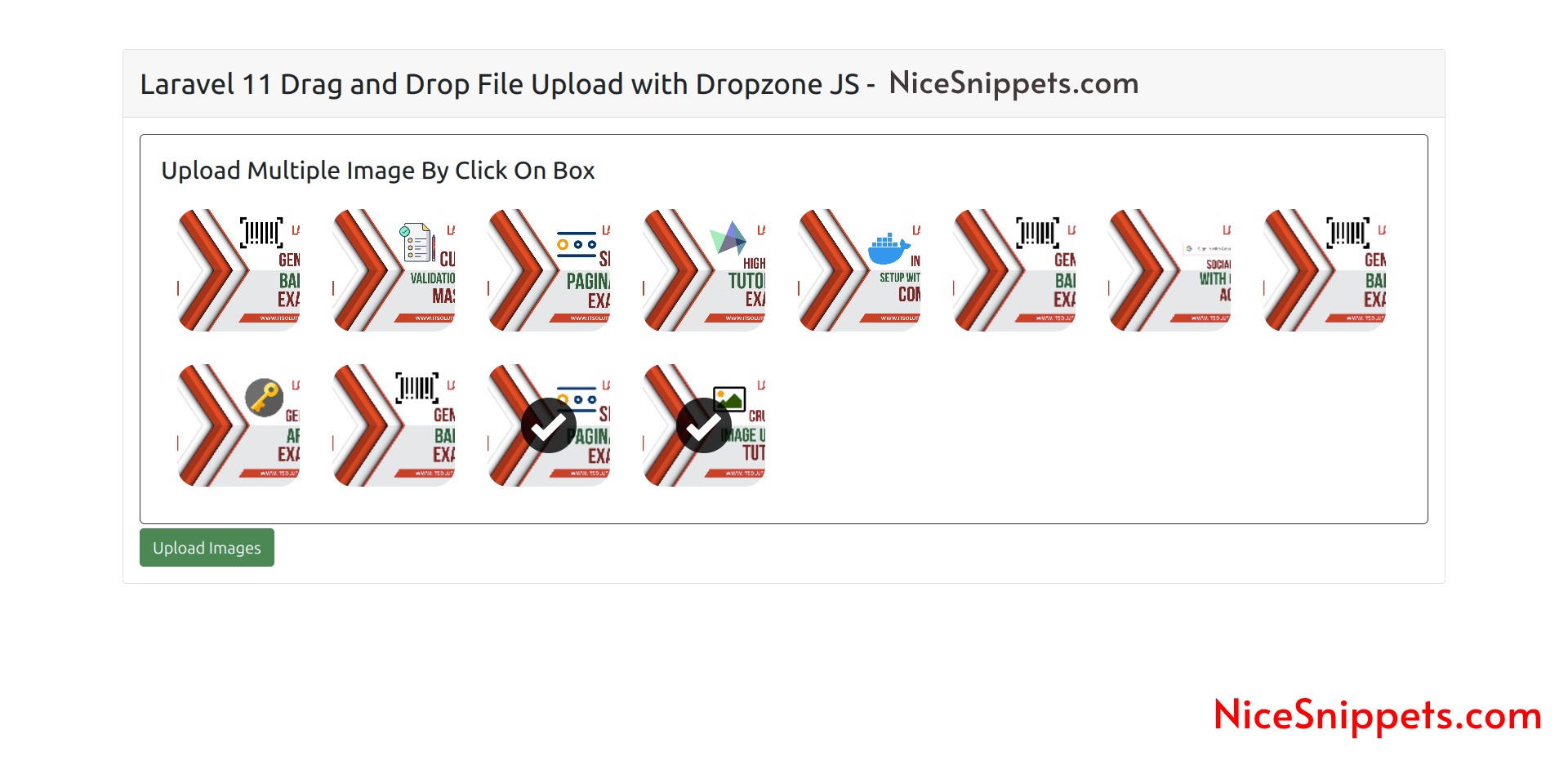18-Apr-2024
.
Admin

Hi, Dev
In this article, I aim to demonstrate the process of implementing drag-and-drop file uploads using Dropzone.js within a Laravel 11 application.
Dropzone.js stands out as a robust library tailored for managing file uploads in web applications. Its functionality simplifies the creation of a drag-and-drop interface, empowering users to seamlessly upload files by dragging them onto a specified region. Moreover, it offers capabilities such as file previews and progress indicators, enriching the user experience during file upload interactions. Leveraging Dropzone.js, developers can elevate the usability and efficiency of handling file uploads on their websites or web applications.
In this example, we'll create an "images" table with "name," "filesize," and "path" columns. Then, we'll design a simple web page where users can drag and drop multiple images to upload. We will use Dropzone.js for drag and drop file upload. We'll save these images both to the "images" folder and the database. We will also show uploaded images on the Dropzone box.
Step for Laravel 11 Dropzone Drag and Drop Image Upload Example
Step 1: Install Laravel 11
Step 2: Create Migration and Model
Step 3: Create Controller
Step 4: Create Routes
Step 5: Create Blade File
Run Laravel App
So, let's follow the steps below to create drag and drop multiple image uploads in the Laravel 11 application example.
Step 1: Install Laravel 11
This step is not required; however, if you have not created the Laravel app, then you may go ahead and execute the below command:
composer create-project laravel/laravel example-app
Step 2: Create Migration and Model
Here, we will create a migration for the "images" table. Let's run the below command and update the code.
php artisan make:migration create_images_table
database/migrations/2022_03_13_140040_create_images_table.php
<?php
use Illuminate\Database\Migrations\Migration;
use Illuminate\Database\Schema\Blueprint;
use Illuminate\Support\Facades\Schema;
return new class extends Migration
{
/**
* Run the migrations.
*/
public function up(): void
{
Schema::create('images', function (Blueprint $table) {
$table->id();
$table->string('name');
$table->string('filesize');
$table->string('path');
$table->timestamps();
});
}
/**
* Reverse the migrations.
*/
public function down(): void
{
Schema::dropIfExists('images');
}
};
Next, run the create new migration using Laravel migration command as below:
php artisan migrate
Now we will create the Image model by using the following command:
php artisan make:model Image
app/Models/Image.php
<?php
namespace App\Models;
use Illuminate\Database\Eloquent\Factories\HasFactory;
use Illuminate\Database\Eloquent\Model;
class Image extends Model
{
use HasFactory;
protected $fillable = [
'name', 'filesize', 'path'
];
}
Step 3: Create Controller
In this step, we will create a new `DropzoneController`. In this file, we will add two methods: `index()` and `store()`, for rendering views and storing images into a folder and implementing database logic.
Let's create the `DropzoneController` by using the following command:
php artisan make:controller DropzoneController
Next, let's update the following code to the Controller file.
app/Http/Controllers/DropzoneController.php
<?php
namespace App\Http\Controllers;
use Illuminate\Http\Request;
use Illuminate\View\View;
use Illuminate\Http\JsonResponse;
use App\Models\Image;
class DropzoneController extends Controller
{
/**
* Generate Image upload View
*
* @return void
*/
public function index(): View
{
$images = Image::all();
return view('dropzone', compact('images'));
}
/**
* Image Upload Code
*
* @return void
*/
public function store(Request $request): JsonResponse
{
// Initialize an array to store image information
$images = [];
// Process each uploaded image
foreach($request->file('files') as $image) {
// Generate a unique name for the image
$imageName = time() . '_' . uniqid() . '.' . $image->getClientOriginalExtension();
// Move the image to the desired location
$image->move(public_path('images'), $imageName);
// Add image information to the array
$images[] = [
'name' => $imageName,
'path' => asset('/images/'. $imageName),
'filesize' => filesize(public_path('images/'.$imageName))
];
}
// Store images in the database using create method
foreach ($images as $imageData) {
Image::create($imageData);
}
return response()->json(['success'=>$images]);
}
}
Step 4: Create Routes
Furthermore, open `routes/web.php` file and add the routes to manage GET and POST requests for rendering views and storing image logic.
routes/web.php
<?php
use Illuminate\Support\Facades\Route;
use App\Http\Controllers\DropzoneController;
Route::get('dropzone', [DropzoneController::class, 'index']);
Route::post('dropzone/store', [DropzoneController::class, 'store'])->name('dropzone.store');
Step 5: Create Blade File
At the last step, we need to create an "dropzone.blade.php" file. In this file, we will create a form with a file input button. So, copy the code below and paste it into that file.
resources/views/dropzone.blade.php
<!DOCTYPE html>
<html>
<head>
<title>Drag and Drop File Upload in Laravel 11 using Dropzone Js - NiceSnippets.com</title>
<link href="https://cdn.jsdelivr.net/npm/bootstrap@5.0.2/dist/css/bootstrap.min.css" rel="stylesheet" crossorigin="anonymous">
<script src="https://cdnjs.cloudflare.com/ajax/libs/jquery/3.7.1/jquery.min.js"></script>
<script src="https://unpkg.com/dropzone@6.0.0-beta.1/dist/dropzone-min.js"></script>
<link href="https://unpkg.com/dropzone@6.0.0-beta.1/dist/dropzone.css" rel="stylesheet" type="text/css" />
<style type="text/css">
.dz-preview .dz-image img{
width: 100% !important;
height: 100% !important;
object-fit: cover;
}
</style>
</head>
<body>
<div class="container">
<div class="card mt-5">
<h3 class="card-header p-3">Drag and Drop File Upload in Laravel 11 using Dropzone Js - NiceSnippets.com</h3>
<div class="card-body">
<form action="{{ route('dropzone.store') }}" method="post" enctype="multipart/form-data" id="image-upload" class="dropzone">
@csrf
<div>
<h4>Upload Multiple Image By Click On Box</h4>
</div>
</form>
<button id="uploadFile" class="btn btn-success mt-1">Upload Images</button>
</div>
</div>
</div>
<script type="text/javascript">
Dropzone.autoDiscover = false;
var images = {{ Js::from($images) }};
var myDropzone = new Dropzone(".dropzone", {
init: function() {
myDropzone = this;
$.each(images, function(key,value) {
var mockFile = { name: value.name, size: value.filesize};
myDropzone.emit("addedfile", mockFile);
myDropzone.emit("thumbnail", mockFile, value.path);
myDropzone.emit("complete", mockFile);
});
},
autoProcessQueue: false,
paramName: "files",
uploadMultiple: true,
maxFilesize: 5,
acceptedFiles: ".jpeg,.jpg,.png,.gif"
});
$('#uploadFile').click(function(){
myDropzone.processQueue();
});
</script>
</body>
</html>
Run Laravel App:
All the required steps have been done, now you have to type the given below command and hit enter to run the Laravel app:
php artisan serve
Now, Go to your web browser, type the given URL and view the app output:
http://localhost:8000/dropzone
Output:

I hope it can help you...
#Laravel 11